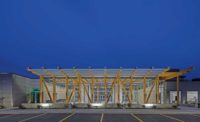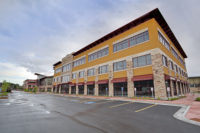
Darrah Jakab is associate principal, sustainable design at MHTN.
Utah is experiencing a series of climate-related issues that significantly complicate the future of water in the region. A megadrought has been going on in the West since the year 2000, and conditions have not been this dry in over 500 years. Unprecedented dry conditions in the Colorado River Basin have led to historically low water levels in Lake Powell and Lake Mead and triggered federal water restrictions for the first time ever this summer. Utah’s temperatures have been steadily increasing in the last 30 years and are expected to be warmer by 2050. A future with higher temperatures and less snow accumulation—with that snow melting earlier—threatens to impact the region’s water supply and Utah’s economy. Utah has been slow to adopt the more aggressive water conservation efforts of neighboring states and is now in a position of needing to make some significant changes to reckon with the implications of a water-scarce future. A concerted, coordinated effort is needed to tackle this challenge on a national, regional and local level. Architects and designers have an important role to play in advocating for water conservation, confronting cultural attachments to turf, implementing adaptable solutions and leading by example.

Peggy McDonough is the president of MHTN.
Utah is one of the most arid states in the country, just behind Nevada and Idaho, and enjoys the cheapest water in the nation. Water districts in Utah are heavily subsidized by property taxes, making the price of water in the state artificially low. Much of the state’s municipal water supplies go toward overwatering lawns. There is an added layer of cultural attachment to lawn, especially Kentucky bluegrass, that is unique to Utah. Water rates are a tool that communicates the value of a resource, and the low value placed on water in Utah has contributed to the reckless use of water in the state.
Water conservation is low-hanging fruit when it comes to sustainability. It can be addressed using sustainable architectural and landscape design practices, and it is far less costly than other solutions that the state is considering, such as the multibillion-dollar Lake Powell Pipeline water project. As Utah’s population is expected to increase by 50% by 2050, solutions that address water-use issues are critical. It becomes challenging for designers to propose solutions that conserve water through native planting and xeriscaping when maintaining a lawn is familiar and less costly. These norms take time to change, and this shift is already beginning.
Utah Legislature recently passed bills that begin to tackle water conservation, including HB 121, which offers cash incentives for private landowners to replace their lawns with drought-tolerant vegetation, and SB 110, which requires municipalities to have water-use and preservation plans. These steps move the needle in the right direction and give architects and designers the opportunity to be agents of change.
The logic is simple: More landscape projects demonstrating water-wise values and more visibility given to drought-tolerant design can begin to shift perceptions and norms about what constitutes a beautiful landscape in Utah.
The more that architects and designers can educate those of us who are especially resistant to change about the resilient qualities of drought-tolerant landscapes and about how we can adapt to a changing climate, the more informed and inventive we will be when it comes to protecting water.





Post a comment to this article
Report Abusive Comment